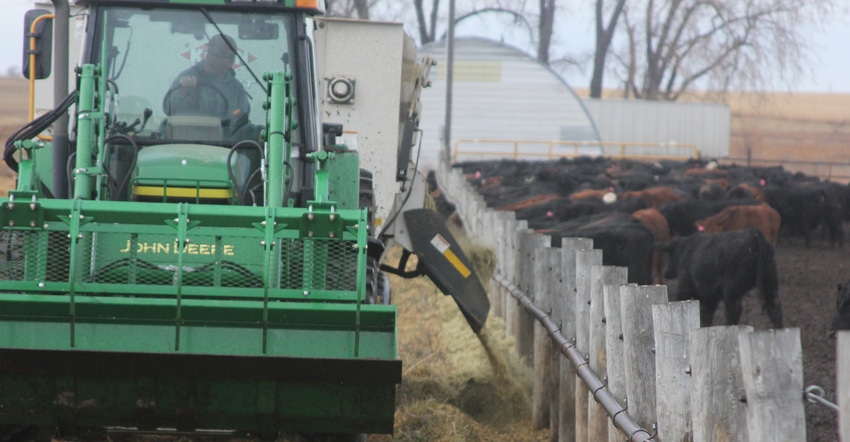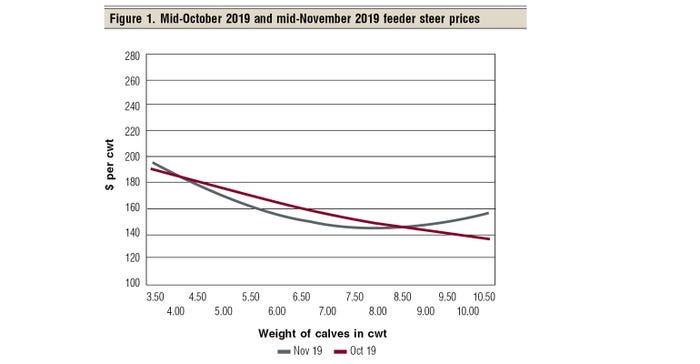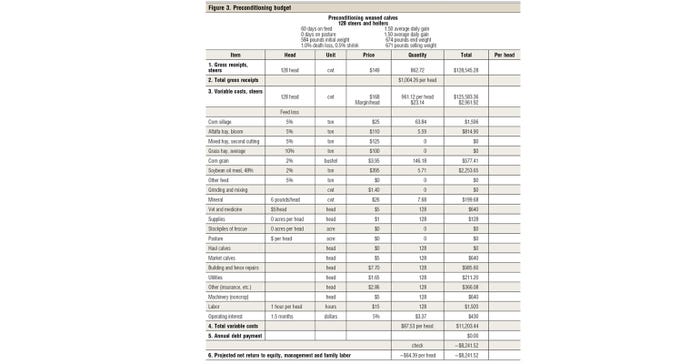There are several options to market your calves. Selling right after weaning is one but is that the best choice as far as return on investment? Or is backgrounding the answer? How about retained ownership? All of these questions are best answered with a budget analysis.
January 2, 2020

Marketing is a real challenge at the bottom of the beef price cycle, and my study herd manager is feeling the current financial pressure in marketing his 2019 calves. This Market Adviser will share the analysis I prepared and discussed with my study herd manager in our November meeting.
Selling weaned calves in mid-November. Mid-November local sale-barn prices did not improve any over mid-October (Figure 1). Normally, feeder steer prices trend downward, as the October line does; however, note the upward turn in the November price line for steer calves 800 pounds and greater. 
The mid-November price line took on a very unusual shape for the heavier-weight feeders. This upturn in price as weight rose is highly unusual. I can only suggest this upturn was due to the strengthening slaughter cattle market in the first half of November. Obviously, cattle feeders wanted these heavier feeders.
However, the November price line was quite normal in the weight range relating to the marketing of my study manager’s calves. The pertinent November feeder cattle marketing prices were slightly lower than the October prices.
Marketing my study herd manager’s 2019 calves in November is still projected to generate a substantial drop in earned net income from his beef cow herd, compared to 2018. The decision not to sell in November was again made.
My study manager simply needs more net income from his 2019 beef cow herd. His 2018 earned net return to family resources from the beef cow herd was $37,500. If he sold his 2019 calves in November, his earned net income from the beef cows would be $16,900. “Not interested in selling” is what I heard loud and clear.
Preconditioning weaned calves. Our conversation soon changed to preconditioning his calves for 60 days and then marketing them this month at the local sale barn. Preconditioning means to prepare the calves to enter the stocker phase of the beef industry, or to be directly placed in the feedlot.
The preconditioning process usually includes activities such as weaning, supplemental nutrition, dehorning, castration, and implementing an animal health program including both deworming and vaccinations. Cow-calf producers can influence the market value of their calves through these industry-accepted management practices.
Of course, there always remains a key question for cow-calf producers who consider preconditioning. Are the additional vaccination, added feed costs and time spent associated with preconditioning economically feasible for a cow-calf producer? This question is best answered with an appropriate budget.
Marketing decisions around preconditioning calves also get more complex. One has to become aware now of not only the market price of the sold calves, but also of the market value of the added weight. With a downward-sloping price line as presented in Figure 1, the value of added weight is always less than the market price of the sold animals.
Each month, I routinely project feeder steer calf prices into the future. Figure 2 presents the appropriate portion of my current January 2020 price projection table generated for mid-November 2019. The preconditioning analysis presented is for 584-pound weaned steer calves preconditioned for 60 days and projected to be marketed this month.

The preconditioned calves are projected sold this month with a projected weight of 674 pounds at a projected price of $149 per cwt. The original weaning price (for mid-October) was projected for 584-pound steer calves selling at $168 per cwt.
When we are adding weight to calves, pricing gets more complex. What becomes critical is the value of the last pound, referred to as the “value of added weight.”
With a downward-sloping price line (see Figure 1), the value of the last pound is always less than the market price. How much less? That is determined by that week’s market price slide.
Based on my price projections for January 2020, the value of the last pound for a steer calf going to 674 pounds is $105 per cwt, not the market price of $149 per cwt. How can that be when the market price at the sale barn is $149 per cwt?
The problem is that even the original 584 pounds at weaning is not valued at the weaning price of $168 per cwt. After preconditioning, those original pounds are now valued at $149 per cwt, for a drop of $19 per cwt. Thus, the value of added weight has to be adjusted for the lost income on the original weaned weight.
Let’s look at this same issue but from another perspective. The value of the original 584-pound weaned calf is $981 per head, and the value of the projected preconditioned calf is $1,004 per head — for an added value from preconditioning of $23 per head before expenses.
Figure 3 presents my preconditioning budget for this group of 2019 steer calves. Item 4 presents the total variable costs of preconditioning of $87.53 per head.

With a total gain of $23.14 per head preconditioned, with the added preconditioning cost of $87.53 per head, we were not interested in preconditioning his calves.
Even after my study herd manager suggested that I added a premium of $5 per cwt for preconditioned calves, I still could not recommend that my study rancher precondition his 2019 calves.
In summary, for any of my readers considering preconditioning their 2019 calves, put together your own budget numbers tailored to your specified beef cow herd and feeds available. Then, draw your marketing conclusions from your own budget numbers.
Hughes is a North Dakota State University professor emeritus. He lives in Kuna, Idaho. Reach him at 701-238-9607 or [email protected].
About the Author(s)
You May Also Like





